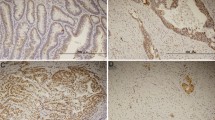Abstract
The objective was to evaluate expression of second mitochondria-derived activator of caspase (Smac) expression before and after treatment in patients treated with preoperative chemoradiotherapy (CRT) for locally advanced rectal cancer and to correlate the clinicopathological characteristics and level of Smac expression with pathologic response and outcome. Expression of biomarker was evaluated by immunohistochemistry in tumor samples from 98 patients with clinical Stage II and III rectal cancer treated with preoperative pelvic radiotherapy plus concurrent chemotherapy. All patients received a standardized total mesorectal excision procedure after a long interval of 4–6 weeks. For Smac, patients with a good response to neoadjuvant CRT tended to have higher pre-therapy levels (P = 0.007). The level of Smac expression decreased after neoadjuvant therapy (P = 0.016). High expression of Smac before CRT, and high Dworak’s tumor regression grade (TRG) were significantly associated with improved 5-year disease-free survival (P < 0.05). Pretreatment nodal status also was significantly associated with 5-year disease-free survival and 5-year local relapse-free survival (P < 0.05). Multivariate analysis confirmed that the pretreatment expression of Smac and Lymph nodal status were independent prognostic factors. Our study suggests that high expression of Smac before neoadjuvant CRT could predict good outcome in locally advanced rectal cancer patients.


Similar content being viewed by others
References
Sauer R, et al. Preoperative versus postoperative chemoradiotherapy for rectal cancer. N Engl J Med. 2004;351(17):1731–40.
Bosset JF, et al. Enhanced tumorocidal effect of chemotherapy with preoperative radiotherapy for rectal cancer: preliminary results—EORTC 22921. J Clin Oncol. 2005;23(24):5620–7.
Bosset JF, et al. Chemotherapy with preoperative radiotherapy in rectal cancer. N Engl J Med. 2006;355(11):1114–23.
Gerard J, et al. Preoperative radiotherapy with or without concurrent fluorouracil and leucovorin in T3–4 rectal cancers: results of FFCD 9203. J Clin Oncol. 2006;24(28):4620–5.
Das P, Crane CH. Preoperative and adjuvant treatment of localized rectal cancer. Curr Oncol Rep. 2006;8(3):167–73.
McLean CM, Duncan W. Rectal cancer: a review of randomized trials of adjuvant radiotherapy. Clin Oncol (R Coll Radiol). 1995;7(6):349–58.
Friedmann P, et al. Pace OT survival following moderate-dose preoperative radiation therapy for carcinoma of the rectum. Cancer. 1985;55(5):967–73.
Kerman HD, et al. Rectal carcinoma. Long-term experience with moderately high-dose preoperative radiation and low anterior resection. Cancer. 1992;69(11):2813–9.
Kim DW, et al. Pre-operative chemo-radio-therapy improves the sphincter preservation rate in patients with rectal cancer located within 3 cm of the anal verge. Eur J Surg Oncol. 2006;32(2):162–7.
Minsky BD. Oxaliplatin-based combined-modality therapy for rectal cancer. Semin Oncol. 2003;30(4):26–33.
Du C, Fang M, Li Y, Li L, Wang X. Smac, a mitochondrial protein that promotes cytochrome c dependent caspase activation by elimination IAP inhibition. Cell. 2000;102(1):33–42.
Dworak O, Keilholz L, Hoffmann A. Pathological features of rectal cancer after preoperative radiochemotherapy. Int J Colorectal Dis. 1997;12(1):19–23.
Song Z, Yao X, Wu M. Direct interaction between survivin and Smac/DIABLO is essential for the anti-apoptotic activity of survivin during taxol-induced apoptosis. J Biol Chem. 2003;278(25):23130–40.
Roberts DL, Merrison W, MacFarlane M, Cohen GM. The inhibitor of apoptosis protein-binding domain of Smac is not essential for its proapoptotic activity. J Cell Biol. 2001;153(1):221–8.
Zheng LD, Xiong ZF, ZHU JW, Wang ZH. Effects of Smac gene over-expression on the radiotherapeutic sensitivities of cervical cancer cell line HeLa. Chin Med J (Engl). 2005;118(3):226–30.
Jia L, et al. Role of Smac in human leukaemic cell apoptosis and proliferation. Oncogene. 2003;22(11):1589–99.
Sekimura A, et al. Expression of Smac/DIABLO is a novel prognostic marker in lung cancer. Oncol Rep. 2004;11(4):797–802.
Conflict of interest
None declared.
Author information
Authors and Affiliations
Corresponding author
Rights and permissions
About this article
Cite this article
Yan, H., Yu, J., Wang, R. et al. Prognostic value of Smac expression in rectal cancer patients treated with neoadjuvant therapy. Med Oncol 29, 168–173 (2012). https://doi.org/10.1007/s12032-011-9819-x
Received:
Accepted:
Published:
Issue Date:
DOI: https://doi.org/10.1007/s12032-011-9819-x




